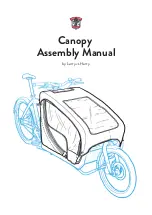
Assembly time should be around 1 hour and
involves mounting the fork and front wheel,
rear mudguard and rear wheel and attaching
the handlebar and stem.
To mount the fork:
Place the larger of the two headset bearings
over the fork steerer and insert the fork into
the headtube. Next, set the remaining
cartridge bearing onto the protruding fork
steerer and insert the retainer clip/preload
spacer. Finally, screw the compression cap
into the fork and tighten by hand until fully
inserted. Then tighten with a 5mm allen key
until no further movement is sensed.
Mounting the rear mudguard and rear wheel:
Required tools: 4/5/6mm allen keys and
10mm spanner.
First, mount the mudguard at the top metal
bracket using the long M4mm and 10mm
spanner, secondly attach the metal support
struts using a 3mm allen key and screw them
into the threaded holes found on the frame
dropouts.
When mounting the rear wheel, first mount
the rear XT derailleur, greasing threads first
and tighening using a 5mm allan key. Place
the wheel carefully in the dropout, taking
care that the disc rotor does not chip pieces
of the brake pad and is aligned. Tighten quick
release axle. Mount chain, ensuring orienta-
tion is correct with chain logos facing
outwards and close off with the Quick Link.
Attaching the cockpit:
The stem and handlebar need to be mounted
onto the steerer rod using allen keys.
Roughly align the front wheel so it is facing
directly forward and slide the stem onto the
steerer rod. Then, screw in the headset top
cap using a 5mm allen key. Finally, tighten
the two rear facing bolts on the stem to 5Nm
ensure the front wheel is properly aligned
and there is no lateral movement in the
headsets.
When setting up your bike for your personal
riding style, it is important to bear in mind
safety and the ability to maintain full control
of the bike under all circumstances. You may
be an extremely experienced cyclist, but the
eBullitt is a very large bike and getting to
grips with the extended front wheel takes
some practise, so air on the side of caution
when initially adjusting seatpost and stem
height. You can always raise the saddle to get
full leg extension later and when the time
comes. Double check the minimum insertion
markings on the seatpost and keep the saddle
level for more effcient riding.
Be sure to take your first ride in an environ-
ment free from traffic and where you can get
accustomed to the steering, controls and
general nuances of the bike. Do not ride on
the pedestrian pavement, it is not cool, gives
cyclists a bad name and can generally get
yourself in a jam. Double check local regula-
tions on carrying children and always ensure
they are strapped in.
Important:
Ensure quick release clamps (if the Q lever
does not make an imprint in your palm, it’s
too loose!) on both the seatpost and the
Easy-Up stemlifter are properly tightened
and that both wheels are secure. Test the
brakes at low speed and your ability to reach
the brake levers. Always wear a helmet (no
discussion!).
Assembly guide
Ensure the battery is fully engaged in the
battery mount and hold down the power
button to initialise the display on the handlebar.
Now, let’s take a look at the controls:
The left hand buttons control the display and
assistance modes; eco, trail and boost mode,
along with walk assist. The more assistance
the motor gives, the easier pedalling
becomes though obviously affects the
longevity of the battery.
Moving over to the right-hand controls:
The buttons determine gear shifting. Finally
the display mounted on the center of the
handlebars controls the bikes menu option
on the left, the power on/off in the center,
and the light on/off on the right side. Use the
shifters to navigate through the menu to find
more settings and options. Holding down the
up/down buttons changes the gears consecu-
tively.
The computer displays both speed and time,
battery levels and chosen assistance mode.
The selected gear is shown in the bar running
along the bottom of the display and in
automatic mode you can select preferred
downshifts so that at traffc lights the eBullitt
changes gear to a lower and easier to pedal
gear upon stopping. Clever huh!
Familiarise yourself with the feeling of the TRP
Quadium E-MTB hydraulic brakes, they are
powerful and the modulation may get a bit of
getting used to.
Quick start guide
Shimano STePS control
Shifters SW-EM800L
6
7






















